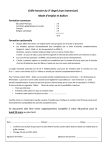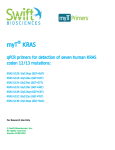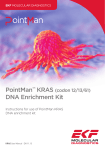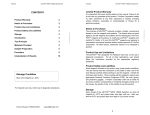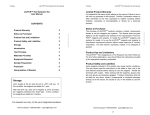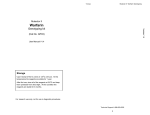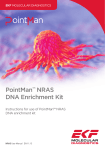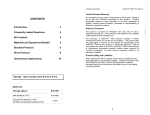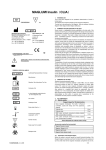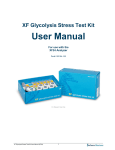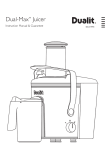Download User Manual V1.1
Transcript
MutectorTM KRAS (GP05-C3) TrimGen MutectorTM KRAS (GP05-C3) TrimGen CONTENTS Introduction Overview of Mutector User Manual V1.1 Cat No. GP05-C3 32 reactions Assay 5 Materials Provided 6 Materials Required 7 Equipment Required 7 DNA Sample Preparation 8 Sequencer Setup 8 Thermal Cycling Programs 9 TM Mutector Assay Protocol 10 A. PCR Amplification 10 B. PCR Product Clean Up 11 C. EM Reaction 12 D. EM Product Clean-up 14 E. Sample Loading 14 F. Data Analysis 15 Storage o Upon receipt of the kit, store at –20 C until use. At this temperature the reagents are stable for 6 months. o After first use, store all of reagents at 2-8 C and keep them protected from direct light. At this condition the reagents are stable for 1 month. 1 2 11-2013 11-2013 Mutation Analysis Reagents (Codons 12 and 13) TM GP05-C3 V1.1 GP05-C3 V1.1 KRAS 4 MutectorTM KRAS (GP05-C3) TrimGen MutectorTM KRAS (GP05-C3) TrimGen Introduction Notice to Purchaser TM The Mutector kit is provided as research use only, not for use in diagnostic procedures. The purchaser must determine the suitability of the product for their particular use. Gly12Ser (GGT>AGT) Gly13Ser (GGC>AGC) Gly12Arg (GGT>CGT) Gly13Arg (GGC>CGC) Gly12Cys (GGT>TGT) Gly13Cys (GGC>TGC) Gly12Asp (GGT>GAT) Gly13Asp (GGC>GAC) Gly12Ala (GGT>GCT) Gly13Ala (GGC>GCC) Gly12Val (GGT>GTT) Gly13Val (GGC>GTC) The kit uses Shifted Termination Assay* (STA) technology to enrich the mutation signal and is able to accurately detect low-level somatic mutations. License TM The purchase of Mutector kit includes a limited, nonexclusive license to use the kit. This license does not grant rights to reproduce or modify TM TM the Mutector kit for resale, or to use the Mutector kit to manufacture commercial products without written approval of TrimGen Corporation. No other license, expressed, implied or by estoppels is granted. * Shifted Termination Assay (STA) Shifted Termination Assay is a proprietary technology that uses uniquely designed primers, mixtures of modified enzymes and specially synthesized nucleotides. STA technology extends primers by multiple bases to increase signal strength and fragment size, creating Product Safety and Liabilities mutation peaks that are easily distinguished from wild type. When working with the kit reagents, always wear a lab coat, disposable gloves, and protective goggles. TrimGen Corporation shall not be liable for any direct, indirect, consequential or incidental damages arising out of the misuse, the results of use, or the inability to use this product. enriched mutation signals are then detected by fragment analysis. The STA technology can detect low-level mutations often missed by sequencing. Trademarks The trademarks mentioned herein are the property of TrimGen or their respective owners. TrimGen Corporation. All rights reserved. Wild type Information in this document is subject to change without notice. Mutant x Mutation Wild type x TrimGen KRAS GP05-C3 manual STA reaction 11-2013 3 The Fragment analysis 4 11-2013 11-2013 It is imperative that the users strictly adhere to this manual. Failure to do so will void TrimGen's guarantee of this product. TrimGen Corporation makes no other warranties of any kind, expressed or implied, including without limitation, warranties of merchantability or fitness for a particular purpose. Codon 13 GP05-C3 V1.1 Limited Product Warranty Codon 12 GP05-C3 V1.1 TRIMGEN DISCLAIMS ALL WARRANTIES WITH RESPECT TO THIS DOCUMENT, EXPRESSED OR IMPLIED, INCLUDING BUT NOT LIMITED TO THOSE OF MERCHANTABILITY OR FITNESS FOR A PARTICULAR PURPOSE. TO THE FULLEST EXTENT ALLOWED BY LAW, IN NO EVENT SHALL TRIMGEN BE LIABLE, WHETHER IN CONTRACT, TORT, WARRANTY, OR UNDER ANY STATUTE OR ON ANY OTHER BASIS FOR SPECIAL, INCIDENTAL, INDIRECT, PUNITIVE, MULTIPLE OR CONSEQUENTIAL DAMAGES IN CONNECTION WITH OR ARISING FROM THIS DOCUMENT, INCLUDING BUT NOT LIMITED TO THE USE THEREOF, WHETHER OR NOT FORESEEABLE AND WHETHER OR NOT TRIMGEN IS ADVISED OF THE POSSIBILITY OF SUCH DAMAGES. TM Mutector KRAS kit is designed to detect 12 mutations occurring in codons 12 and 13 of KRAS gene. MutectorTM KRAS (GP05-C3) TrimGen MutectorTM KRAS (GP05-C3) TrimGen Overview of MutectorTM Assay Materials Provided: The Mutector 32 tests. PCR amplification TM KRAS Mutation Differentiation kit contains reagents for Materials 1.5 hours* Quantity KRAS PCR Primers 50μl PCR primer mix for amplification of KRAS gene Clean-up Enzymes 430μl Enzyme mix for cleanup of PCR products GP05-C3 V1.1 KRAS EM-12* 430μl Pre-mixed reagents for enrichme nt and detection of codon 12mut ations KRAS EM-13* 430μl Pre-mixed reagents for enrichme nt and detection of codon 13mut ations 11-2013 30 min EM reaction KRAS DP-12 80μl Pre-mixed detection primers for codon 12mutations KRAS DP-13 80μl Pre-mixed detection primers for codon 13mutations KRAS Control Codon 12 50μl Mutation controls for codon 12 KRAS Control Codon 13 50μl Mutation controls for codon 13 1000μl x 2 Sample loading buffer with size standards Mutation enrichment and detection 45 min* (codon 12) (codon 13) * Time varies by thermal cycler used EM products cleanup 5 min (codon 12) Loading Buffer* TF-50 Filters 64 Filter tip for reaction clean up Collection Tubes 64 Collection tube for the TF-50 filter (codon 13) * Light sensitive: Wild type Keep these reagents protected from direct light. Capillary Electrophoresis Fragment analysis 30-40 min Mutation 5 6 11-2013 Reagents for DNA amplification GP05-C3 V1.1 650μl * Time varies by thermal cycler used PCR product clean up Description Master Mix MutectorTM KRAS (GP05-C3) TrimGen DNA Sample Preparation: TF-50 Filter Filter tip to remove free fluorescent dyes. Reagents for DNA preparation are not provided with the kit. Paraffin (FFPE) and fresh or frozen tissue samples A kit specially designed for FFPE samples is available at TrimGen TM (WaxFree DNA, Cat. WF-50 for 50 samples, WF-100 for 100 samples). o Store the filters at 2-8 C. If the buffer inside the tip evaporated, or completely dried, add 200l deionized water, soak the gel overnight. The tip is ready to use. Buffer 0.2 ml PCR tubes (8-well strip tube) DNA concentration adjustment: When using a column or bead DNA extraction method, adjust the final concentration of extracted DNA to 20-80 ng/l. The DNA concentration calculated using classical UV method (measure OD) may give incorrect DNA concentration. A fluorescent method that directly measure intact DNA, such as pico green method, is recommended. DS-32 Matrix Standard Kit for calibration of sequencer (Applied Biosystems Pat No. 4345831) When using TrimGen’s FFPE DNA preparation kit, follow the kit protocol to perform the PCR reaction. Equipment required: Sequencer setup: Thermal Cycler: Any type of thermal cycler with a 0.2 ml tube block is acceptable for performing the assay. First time users should set up the analysis program for the ABI sequencer (one time setup). After setup, the program can apply to all Mutector™ tests for data analysis. Sequencer: Applied Biosystems Genetic Analyzer Instrument Genetic analyzer 3100 Genetic analyzer 3700 GeneMapper® Analysis Data Collection Data Analysis Data Collection Software v3.0 or v3.1 GeneMapper® Software v4.0 or v4.1 Step II. Data Collection® Software Setup www.trimgen.com/docs/PartII-Data-Collection-Setup.pdf Genetic analyzer 3130 Genetic analyzer 3500 Step I. GeneMapper® Setup www.trimgen.com/docs/PartI-GeneMapper-Setup.pdf 3500 Data Collection Software v1.0 7 GeneMapper® Software v4.1 Step III. Data Analysis Using GeneMapper® www.trimgen.com/docs/PartIII-Data-Analysis-GeneMapper.pdf 8 11-2013 11-2013 Materials required: Blood Any commercially available DNA extraction kit is acceptable. GP05-C3 V1.1 Dry Dried GP05-C3 V1.1 Snap off-line. Before spin the filter tip, snap off bottom of the tip. Good MutectorTM KRAS (GP05-C3) TrimGen MutectorTM KRAS (GP05-C3) TrimGen Important Spectral calibration is required before running the test Thaw all reagents and keep on ice. Spin down the reagents before use. o 1 cycle 94 C 5 min 35 cycles 94 C 30 sec o 52 C 30 sec o 72 C 30 sec KRAS Controls Codon 12 (C12) and KRAS Controls Codon 13 (C13) are required for each test run. A negative control (water) is recommended to run with the samples each time. A.1. Prepare PCR Reaction Mix: + 3*) x 1.1** = Master Mix = 18 x ( l 11-2013 11-2013 Program 1 (PCR) 1 cycle A. PCR Amplification # of Samples + 3*) x 1.1** = KRAS PCR Primers = 1 x ( l # of Samples o o 72 C 5 min o *For negative and KRAS controls (C12 & C13). ** For pipetting error. Transfer entire volume of the reagents to one tube and gently mix (avoid bubble) the contents. This is the PCR Reaction Mix. Hold at 4 C Program 2 (Clean-up) A.2. Collect 0.2 ml PCR strip tubes and label the tubes as follows: o 37 C 25 min o 95 C 5 min Sample 1, 2, 3 …… o Hold at 4 C Program 3 (EM reaction) o 1 cycle 94 C 4 min 20 cycles 94 C 45 sec o 60 C 20 sec o 70 C 20 sec Neg C12 C13 1 2 3 4 Neg: Negative control (water) C12: KRAS Controls Codon 12 C13: KRAS Controls Codon 13 o o Hold at 4 C A.3. Transfer 19l of PCR Reaction Mix into all of the tubes. A.4. Add 2l of nuclease-free water to the “Neg” tube. A.5. Add 2l of KRAS Controls Codon 12 to the “C12” tube. 9 10 GP05-C3 V1.1 Thermal Cycling Programs: MutectorTM Assay Protocol: GP05-C3 V1.1 The sequencer needs to be calibrated with the DS-32 calibration kit (Applied Biosystems cat No. 4345831). This is a one-time calibration to set up spectral channels to collect the test results. Refer to the DS-32 Matrix standards kit to prepare the DS-32 matrix standards. Run a Matrix Standard Set DS-32 (5FAM, JOE, NED, ROX) to perform a spectral calibration. MutectorTM KRAS (GP05-C3) TrimGen MutectorTM KRAS (GP05-C3) TrimGen A.6. Add 2l of KRAS Controls Codon 13 to the “C13” tube. During the incubation, prepare step C1-C4. A.7. Add 1-2l* of sample DNA (20-80 ng/l) to each sample tube. When using TrimGen WaxFree kit for paraffin sample DNA extraction, add 0.5-1l* final extract to each sample tube. C. Mutation Enrichment and Detection (EM reaction) C.1. Collect two 2 ml tubes and label one tube with “EM12” and the other tube with “EM13.” Prepare EM mix as follows: Add too much sample may cause an inhibition of PCR reaction. A.8. Place the PCR tubes in a thermal cycler and run Program 1. 94 C 5 min o 35 cycles 72 C 5 min o Hold at 4 C Optional: The PCR product can be verify by agarose gel (5 l loading). The correct band size is 120 bp. The procedure can be temporarily stopped after Program 1. o The PCR products can be stored at 4 C for 2-3 days. During the PCR, prepare step B1-B2. KRAS DP-12 = 2 x ( B.2. Add 11l of Clean-up Enzymes (C-UP) to each new tube. B.3. Transfer 4l of PCR products to each tube (the remaining PCR products can be stored at –20C for re-test). l + 2*) x 1.1 = * For Controls Add the reagents to the tube and mix gently. Tube EM13 - EM13 mix for codon 13: KRAS EM-13 = 11 x ( + 2*) x 1.1 = KRAS DP-13 = 2 x ( l + 2*) x 1.1 = # of Samples * For Controls Add the reagents to the tube and mix gently. C.2. Collect 0.2 ml strip tubes (2 tubes per sample and 4 control tubes for each test run). Label the tubes as follows: One set for codon 12 (EM12 set) and another set for codon 13 (EM13 set). C-up treated Controls B.5. Incubate the tubes in a thermal cycler using Program 2. EM12 set Neg C12 1 2 3 EM13 set Neg 1 2 3 o 37 C for 25 min o 95 C for 5 min C13 o Hold at 4 C 11 l # of Samples B.4. Mix the contents and spin all tubes. Program 2 l # of Samples B. PCR Products Clean Up B.1. Collect 0.2 ml strip tubes, one tube for each PCR reaction. Label the tubes the same as the PCR tubes. + 2*) x 1.1 = # of Samples C-up treated PCR Samples 12 11-2013 o 1 cycle 11-2013 94 C 30 sec o 52 C 30 sec o 72 C 30 sec KRAS EM-12 = 11 x ( GP05-C3 V1.1 o 1 cycle Tube EM12 - EM12 mix for codon 12: GP05-C3 V1.1 Program 1 MutectorTM KRAS (GP05-C3) TrimGen MutectorTM KRAS (GP05-C3) TrimGen D. EM Product Clean-up C.3. Transfer 13l of EM12 mix (from step C.1) into all tubes in EM12 set. Filter Tip Preparation C.4. Transfer 13l of EM13 mix (from step C.1) into all tubes in EM13 set. C.9. Mix the contents and spin all tubes. C.10.Place the tubes into the thermal cycler and perform EM reaction using Program 3. Program 3 o 1 cycle 94 C 4 min 20 cycles 94 C 45 sec o 60 C 20 sec o 70 C 20 sec D.3. Centrifuge the TF-50 Filter Tips at 1,000 x g (3000 rpm for most tabletop centrifuge) for 2-3 minutes to remove the buffer from the filters. D.4. Discard the Collection Tubes and move the TF-50 Filter Tips into a new Collection Tube. Label the Collection Tubes with sample ID. The TF-50 Filter Tips are ready for use. D.5. After the EM reaction, load entire 15l reaction mix onto the top of gel in each of pre-prepared TF-50 Filter Tips. D.6. Centrifuge the TF-50 Filter Tips at 1,000 x g (3000 rpm for most tabletop centrifuge) for 2-3 minutes. o D.7. Discard the TF-50 Filter Tips. The solution in the collection tubes contains cleaned EM reaction products and is ready for sample loading. o Hold at 4 C E. Sample Loading E.1. Add 15µl of the Loading buffer to each well of a sequencer adapter plate. During the EM reaction, prepare step D1-D3. E.2. Transfer 2-4µl of the filtered EM products into each well. E.3. Load the plate to sequencer and run the pre-set Data Collection Program (ref. page 8). 13 14 11-2013 C.8. Add 2l of C-up treated Sample (from step B.5) to each corresponding sample tube in both EM12 and EM13 sets. 11-2013 C.7. Add 2l of C-up treated C13 (from step B.5) to the “C13” tube. D.2. Snap off the bottom portion of the filter tip (ref. page 7 for snap off-line) and put tip back to collection tube. GP05-C3 V1.1 C.6. Add 2l of C-up treated C12 (from step B.5) to the “C12” tube. D.1. Collect the TF-50 Filter Tips and Collection Tubes (one set for each EM reaction). GP05-C3 V1.1 C.5. Add 2l of C-up treated Negative PCR control to the “Neg” tube in both EM12 and EM13 sets. MutectorTM KRAS (GP05-C3) TrimGen MutectorTM KRAS (GP05-C3) TrimGen MutectorTM KRAS (GP05-C3) TrimGen Results for KRAS Controls Codon 13 F. Data Analysis 7 peaks will be presented as follows: The KRAS Controls Codon 12 and Codon 13 represent the mutation patterns (color and size). Use these controls as standards to identify the peaks present in the test samples. Results for KRAS Controls Codon 12 8 peaks will be presented as follows: 5 # Peak Color 1 Black Wild type 2 Black Mutation GGT>GTT 3 Red Mutation GGT>GAT 4 Blue Mutation GGT>GCT 5 Black Mutation GGT>TGT 6 Blue Mutation GGT>CGT 7 Red Mutation GGT>AGT 8 Red Mutation GGT>GTT Size 50 2 1 Interpretation 5 GGC>AGC (red) 2 6 7 3 Read the peaks from right, and write the peak size in table below: # Peak Color Interpretation 1 Black Wild type 2 Blue Mutation GGC>CGC 3 Red Mutation GGC>AGC 4 Black Mutation GGC>TGC 5 Blue Mutation GGC>GCC 6 Red Mutation GGC>GAC 7 Black Mutation GGC>GTC Any peaks that not match the peaks in this panel are disregarded. The pattern, size or position of the peaks may vary slightly depending on instrument, polymer type and the length of capillary. Customer should validate the correct size for each peak by using the KRAS Controls Codon 12 and 13. Any peaks that do not match the peaks in this panel are to be disregarded. Two GTT mutation peaks are shown in this panel: one peak (#2) is next to and has the same color as the wild type peak. When the resolution of capillary or polymer is low, the mutant peak may merge with the wild type peak, which makes it difficult to identify the mutation. To overcome this issue, a special primer is designed to generate the other peak (#8) with a different size and color. 15 1 16 11-2013 8 3 Wild Type 11-2013 7 4 4 Wild Type (black) GGC>CGC (blue) GP05-C3 V1.1 GP05-C3 V1.1 6 GGC>GTC (black) GGC>TGC (black) GGC>GCC (blue) GGC>GAC (red) MutectorTM KRAS (GP05-C3) TrimGen MutectorTM KRAS (GP05-C3) TrimGen Mutations in Codon 13 Sample Analysis The wild type peak is a black peak on the right (largest peak size). The mutation(s) will show as additional peak(s). All mutation peaks are smaller than the wild type. The peak size and color of the mutation peaks in the KRAS Controls Codon 12 and 13 are used as references to identify mutations in the sample. Wild Type Wild Type 11-2013 GGC>CGC mutation The following data derived from Genetic Analyzer 3130 using 36cm capillary array and POP-7 polymer. Wild Wild Type Type Wild Type Wild Type Wild Type GGT>GAT mutation GGT>AGT mutation GGT>CGT mutation GGT>TGT mutation GGC>TGC mutation GGC>GTC mutation Mutations in Codon 12 GGT>GCT mutation Wild Type GGT>GTT mutation Wild Type 17 Wild Type Wild Type 18 GP05-C3 V1.1 Example GGC>GCC mutation GGC>AGC mutation 11-2013 The peak size between the control and the sample panel may slightly shifted due to migration differences between individual capillary tubes. GP05-C3 V1.1 Any peaks that do not match the correct size and color are not considered as mutations. GGC>GAC mutation Wild Type Wild Type Wild Type











